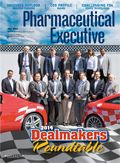Vaccines: Fire in the Cold Chain
Its only recently that vaccine producers experienced the commercial returns commensurate with vaccines: long record of positive public health performance.
Vaccines are a proven and cost-effective preventative therapy for numerous disabling and fatal diseases, producing significant public health gains that generate tens of billions of dollars in health system savings each year. Only recently, however, have vaccine producers experienced the commercial returns commensurate with this long record of positive public health performance. Vaccines are now the industry standout in delivering high rates of revenue growth, with double-digit increases of 10% to 15% annually, which are expected to continue for the next several years, significantly outpacing the 6% to 7% growth rate we see in traditional pharma.
The sector's improving prospects are driven by a surge of innovation in the underlying science of disease prevention as well as the increasing importance that national health systems attach to vaccines as their primary tool in the fight against communicable disease. These factors are driving change across manufacturers and their products as well as with markets and key customers. In the era of patent cliffs and shrinking pipelines, the high rates of post-Phase III R&D success in vaccines combined with a long product life cycle—often extending well beyond patent expiry—has forced the broader industry to look at vaccines anew. Nevertheless, companies seeking to benefit from this growth must adapt to a fast-evolving environment that includes lengthy clinical development timeframes, large investments in complex manufacturing platforms, and an often politicized price and reimbursement structure that demands significant attention to building relationships with numerous external stakeholders.

Photo: Thinkstock
Key growth factors
There is significant untapped potential in the preventive vaccines market. Unmet needs remain since many diseases still have low immunization rates or no available vaccine. Financial analysts have projected the market to reach $39 billion in 2015. The World Health Organization (WHO) expects the global market to soar to $100 billion by 2025, with 120 new products flowing from company pipelines over the next decade.
A range of factors are driving this growth. Our experience in the industry has highlighted three: an increase in awareness of infectious diseases, changes in the global reimbursement landscape, and higher prices for new vaccines.
Increased awareness of infectious and communicative diseases: National governments are the dominant customer globally and play a substantial role in purchasing, enforcing safety regulations, and influencing uptake. Over the past decade, governments and supranational organizations have expressed growing concern over public awareness of infectious disease prevention, dedicating substantial investment in mass immunizations and outreach programs in efforts that translate into opportunity for manufacturers.
Global outbreaks of vaccine-preventable diseases have driven much of the growth in public awareness. Seasonal influenza outbreaks like the H1N1 strain have claimed many thousands of lives and taken enormous tolls on national health expenditure. Growing awareness provides the impetus for governments to invest in programs aimed at preventing onset of future outbreaks. These programs supply funding for mass immunization programs, which play an instrumental role in elevating uptake. The WHO, for instance, now supports campaigns that provide not only funding but bottom-up infrastructural support, through numerous public outreach programs for vaccination, including sponsorship of the annual World Immunization Week.
Recent examples of how outbreaks can impact awareness and government policy are the meningococcal B (MenB) outbreaks, which led to meningitis cases and at least one death on a handful of US college campuses. In response, the US CDC and FDA made Novartis' Bexsero vaccine available for use with limited populations despite the product not being broadly licensed for use in the US. In addition, Bexsero and Pfizer's rLP2086 recently received "breakthrough" designation from the FDA, making these two products eligible for accelerated review. We anticipate an updated Advisory Committee on Immunization Practices (ACIP) recommendation for MenB vaccine use. Such a recommendation is expected to compel most payers to cover the product for eligible populations.
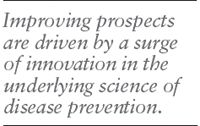
Non-profit and non-governmental organizations, such as the Gates Foundation, the Clinton Health Access Initiative, Global Alliance for Vaccines and Immunization (GAVI), as well as many others are increasingly influential as brokers in the negotiation of vaccine purchasing for ministries of health for developing nations and/or as advocates for vaccine use. Each of these groups are receiving more philanthropic support. They also provide access to medications in emerging and developing markets, prioritize vaccination on public health agendas, and help shape national immunization program strategies on coverage, pricing, and uptake.
Better access and more predictable pricing: Immunization is attracting more attention on national health agendas; governments, in collaboration with supranational organizations, have responded by improving or adding vaccine coverage linked to preventive public health interventions. Provisions in the 2010 US Affordable Care Act mandate all health insurance plans to make recommended vaccines available with no out-of-pocket deductible or co-payment incurred to the patient, a provision that is intended to bring improved prevention coverage for 88 million beneficiaries by 2013.
Other mature markets, including Japan, have increased their emphasis on vaccination as a public health priority. In an effort to narrow the country's historical "coverage gap," Japan's Ministry of Health, Labor, and Welfare (MHLW) has poured investments into the vaccines manufacturing and R&D pipelines of Takeda, Astellas, Daiichi Sankyo, and Mitsubishi Tanabe to promote immunizations against prevalent infectious conditions. The MHLW has provided generous incentives for vaccine manufacturers, funded awareness programs, and by 2015, aims to include HPV, Hib, pneumococcal, varicella, mumps, and hepatitis B vaccinations as part of the national immunization program. The Japanese vaccines market has grown at a 28% CAGR from 2006-2011.
Uptake is also heavily driven by improved vaccine coverage and distribution in emerging markets (see chart below). Argentina, which currently has one of the most comprehensive national immunization programs in Latin America, provides vaccines for free and has expanded the number of mandatory vaccines from six to 16 over the past ten years. Moreover, Argentina's Ministry of Health aims to increase the percentage of covered individuals from 80% to 95% and has drafted plans to expand its vaccine distribution system to ensure universal access. Brazil currently leads Latin American countries in immunization protection, with 26 products covered under the national immunization program. In China, select provinces and cities have instituted regional programs for flu and select pediatric vaccines designed to lessen the individual financial burden of vaccines that are not covered for patients.
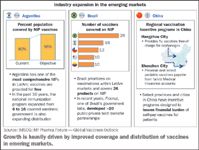
Growth is heavily driven by improved coverage and distribution of vaccines in emering markets.
More evidence of the importance of immunization in emerging markets is the increasing activity of local mid-sized manufacturers and government labs. China's Sinovac, Brazil's Butantan Institute, South Africa's Biovac, Mexico's Birmex, and the Government of India's Serum Institute are developing newer vaccines, investing in more advanced manufacturing technologies, and experiencing higher uptake of in-line products. Brazil has made technology transfer a critical part of its overall national vaccine policy as was seen with Brazil's Ministry of Health agreement to purchase $2.2 billion worth of GSK's Synflorix in return for a gradual receipt of the technology to independently manufacture the vaccine after the end of the 10-year-long contract. Sanofi has partnered with Birmex in Mexico and Butantan in Brazil in a tech transfer agreement for its influenza vaccine. Many of the mid-size institutes have entered into purchasing agreements with supranational organizations such as GAVI, the Bill and Melinda Gates Foundation, and the Program for Appropriate Technology in Health (PATH).
Strong innovation is reflected in elevated price levels: Part of the sector's growth is derived from the higher prices newer first-in-class products have commanded based on the value they provide (see chart below). Wyeth launched Prevnar-7 in 2000 at a price that exceeded most other pediatric vaccines combined while still demonstrating high cost-effectiveness. Merck's Gardasil for human papillomavirus was priced at near $400 upon launch in 2006. With increased value driven by six additional strains, Pfizer's launched Prevnar-13 at a price of approximately $513 per course.
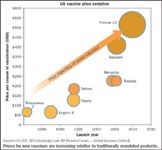
Prices for new vaccines are increasing relative to traditionally mandated products.
Even in categories that are crowded with competition, innovation has enabled price differentiation, as evidenced by Sanofi Pasteur's Fluzone HD, which is targeted at the elderly sub-segment of the overall flu market where unmet need is most pronounced. While Fluzone HD has not demonstrated greater protection from influenza disease than regular flu vaccines at the time of this writing, it has demonstrated improved immune response in clinical trials. Significantly, the private list price for Fluzone HD is more than twice that of multiple standard dose flu products. AstraZeneca's FluMist was recently able to gain a CDC recommendation at the other end of the age spectrum. The CDC indicated that influenza incidence was markedly lower in the 2- to 8-year-old age group when vaccinated with a nasally administered vaccine. FluMist also commands a premium price in the market.
In addition to the drivers already mentioned, we have also seen growth from successful lifecycle management strategies. The two largest-grossing products in the preventative vaccine industry, Gardasil and Prevnar, are perfect examples. Gardasil for instance, doubled its eligible recipient base after receiving approval for male anal cancer, genital warts, and pre-cancerous lesion indications. In January 2013, Pfizer's Prevnar similarly received a nod from the FDA for an age 50+ expansion, a decision that has led Wall Street analysts to project an increase in sales from $4 billion to $5 billion a year. Vaccines that currently lead market sales have and will continue to provide a steady source of growth, and manufacturers intend to leverage R&D, manufacturing, and marketing capacity and increase year-on-year investments on promotional spend, post-marketing surveillance studies, and indication expansions.
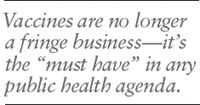
Industry growth has led to M&A activity: Many large-scale manufacturers have turned to vaccines to drive sustained growth and branded revenue. In 2010, the industry reported over 195 vaccine partnering deals, including Johnson & Johnson's acquisition of Crucell, a $2.3-billion deal which strategically introduced the big pharma conglomerate to the mid-size vaccine manufacturer's portfolio of pediatric, endemic, and travel vaccine assets.
Other notable deals include GSK's recent $5.25 billion initial cash purchase of Novartis's non-influenza vaccine assets, in return for the transfer of GSK's oncology franchise and the development of a distinct consumer healthcare business. This brings to GSK a portfolio of travel assets that includes a promising meningitis vaccine franchise. Sanofi Pasteur's acquisition of Acambis in 2008 augmented the second-largest vaccine manufacturer's flu and tailored multivalent combinations with West Nile and dengue fever travel vaccine assets. In 2007, AstraZeneca acquired MedImmune for $15.6 billion in a deal that through Synagis and FluMist, positioned the company as the sixth-largest vaccines manufacturer. Takeda (see sidebar) launched a new business unit dedicated to vaccines in early 2012, and Mitsubishi Tanabe acquired Canadian company Medicago, thereby getting access to Medicago's innovative technology for producing vaccine-like particles from tobacco plant leaves.
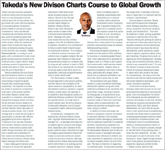
Takeda’s New Divison Charts Course to Global Growth
What's next in vaccines
The next generation in vaccines development will rely on platform strategies founded on genomics, reverse vaccinology, high throughput DNA sequencing, new plant and insect based expression and production systems, and new more potent vaccine adjuvants. These developments carry the potential to rapidly produce novel, optimal and cost-effective vaccine targets that carry high chances of success in clinical development programs. Promising new vaccine candidates such as meningococcal-B, GBS, methicillin-resistant Staphylococcus aureus, pneumococcal, and pathogenic E. coli are already in development. Not only do these new platforms improve the prospects for vaccines against major infectious diseases such as AIDS, tuberculosis, dengue, and malaria, they also provide a basis for therapeutic-based vaccine development against other new and emerging conditions, including allergies, autoimmune disorders, and cancer.
Business points to ponder
New markets and diseases, specialized target populations, and increasing needs for preventive vaccines all lead to new opportunity, but also impose new challenges. The key strategic questions manufacturers will need to address include:
» How to price products whose commercial benefit will rest predominantly in emerging markets?
» How to effectively capture niche populations within an established vaccine disease area?
» Within the structure of public health requirements and recommendations, how can technology advances be effectively translated into commercial advantage?
The benefits that the vaccine market offers will accrue to those who are able to creatively adapt and build on past approaches while incorporating the advances of new science and a more supportive policy environment: vaccines are no longer a fringe business—it's the "must have" in any public health agenda.

Kevin Fitzpatrick is a Principal at IMS Consulting Group. He can be reached at KFitzpatrick@imscg.com. Nitin Mohan is Engagement Manager at IMS Consulting. He can be reached at NMohan@imscg.com. The authors wish to thank Amy Guan for her contributions.
Addressing Disparities in Psoriasis Trials: Takeda's Strategies for Inclusivity in Clinical Research
April 14th 2025LaShell Robinson, Head of Global Feasibility and Trial Equity at Takeda, speaks about the company's strategies to engage patients in underrepresented populations in its phase III psoriasis trials.
Bristol Myers Squibb’s Cobenfy Falls Short in Phase III Trial as Add On Therapy for Schizophrenia
April 23rd 2025In the Phase III ARISE trial, Cobenfy administered as an adjunctive treatment to atypical antipsychotics for patients with inadequately controlled schizophrenia did not achieve statistically significant improvements.
Key Findings of the NIAGARA and HIMALAYA Trials
November 8th 2024In this episode of the Pharmaceutical Executive podcast, Shubh Goel, head of immuno-oncology, gastrointestinal tumors, US oncology business unit, AstraZeneca, discusses the findings of the NIAGARA trial in bladder cancer and the significance of the five-year overall survival data from the HIMALAYA trial, particularly the long-term efficacy of the STRIDE regimen for unresectable liver cancer.
Expanding Immune Response Testing to Support Vaccine Development
April 22nd 2025Nigel McCracken, chief operating officer, Virax Biolabs, discusses the expansion of its ViraxImmune platform into areas such as transplant monitoring, vaccine efficacy, latent virus reactivation, and CAR T cell therapy.
